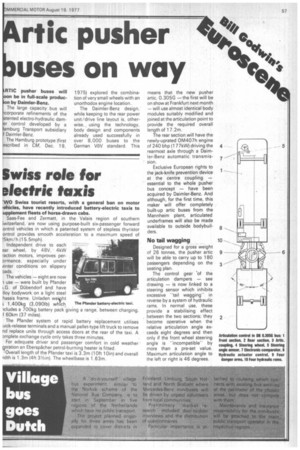Artic pusher 44 6?
Page 59

If you've noticed an error in this article please click here to report it so we can fix it.
buses on way
IRTIC pusher buses will oon be in full-scale producon by Daimler-Benz.
The large capacity bus will -icorporate refinements of the atented electro-hydraulic darner control developed by a amburg Transport subsidiary
Daimler-Benz.
The Hamburg prototype (first escribed in CM, Dec. 19, 1975) explored the combination of very small wheels with an unorthodox engine location.
The Daimler-Benz design, while keeping to the rear power unit/drive line layout is, otherwise, using the technology. body design and components already used successfully in over 8,000 buses to the German ViiV standard. This means that the new pusher artic, 0.305G --the first will be on show at Frankfurt next month — will use almost identical body modules suitably modified and joined at the articulation point to provide the required overall length of 17.2m.
The rear section will have the newly-uprated 0M407h engine of 240 bhp (177kW) driving the rearmost axle through a Daimler-Benz automatic transmission.
Exclusive European rights to the jack-knife prevention device at the centre coupling — essential to the whole pusher bus concept — have been acquired by Daimler-Benz. And although, for the first time, this maker will offer completely built-up artic buses from the Mannheim plant, articulated underframes will also be made available to outside bodybuilders.
No tail wagging
Designed for a gross weight of 26 tonnes, the pusher artic will be able to carry up to 180 passengers depending on the seating plan.
The control gear of the articulation dampers — see drawing — is now linked to a steering sensor which inhibits excessive "tail waggingin reverse by a system of hydraulic rams. In normal use, these provide a stabilising effect between the two sections; they become operative when the relative articulation angle exceeds eight degrees and then only if the front wheel steering angle is "incompatible" by more than a pre-set value. Maximum articulation angle to the left or right is 46 degrees.




































































































